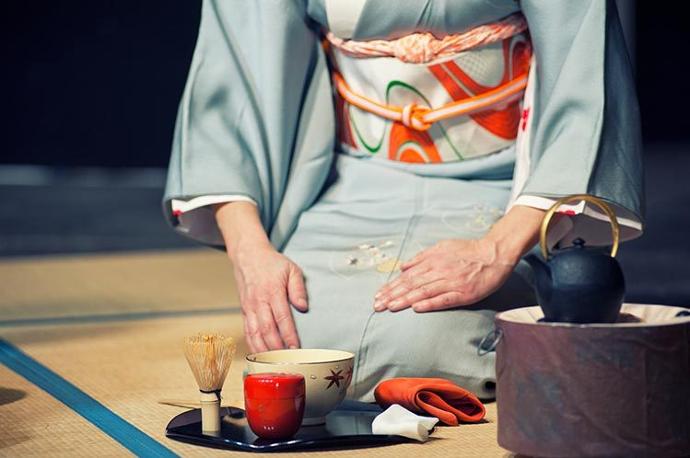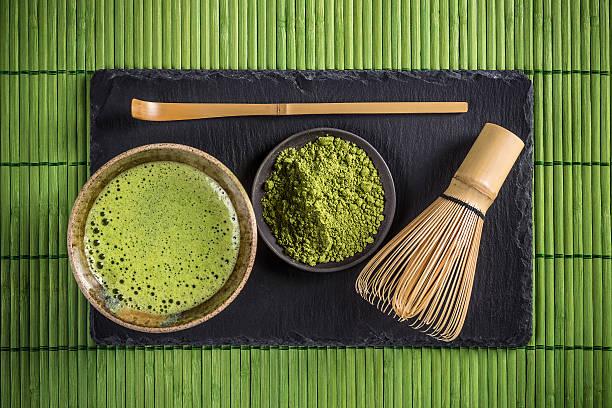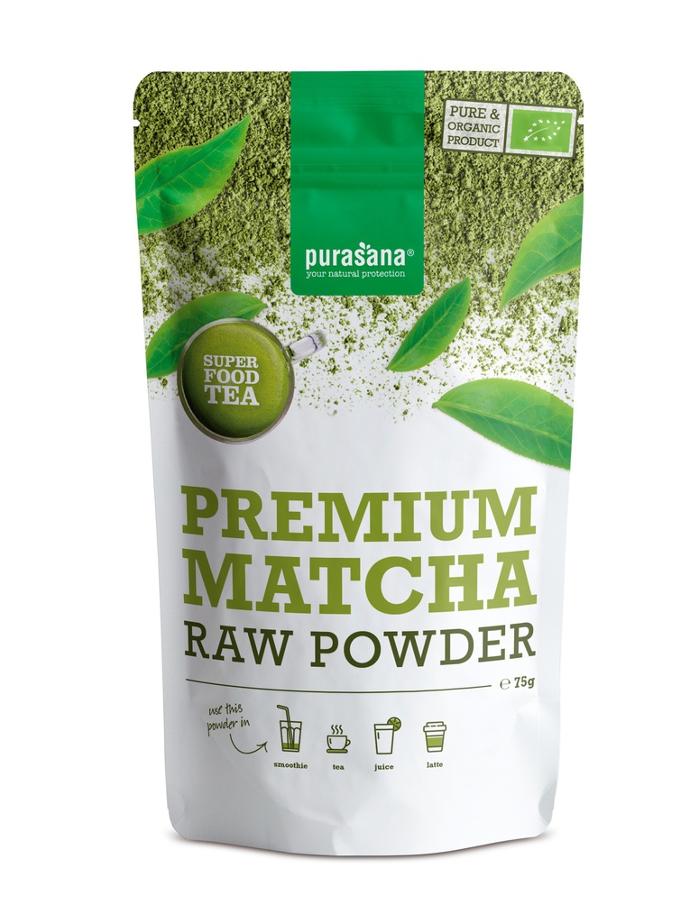Happiness is in the matcha tea, to be more precise.
Researchers have revealed the ability of this tea to modify the mood of depressed mice(1).
Although no study has yet been conducted on humans, it would seem that matcha is a source of benefits for our brain... and this is only a small part of the health benefits of this exceptional tea.
What is the tea ceremony?
The matcha is a high quality green tea, made from the leaves of Camellia sinensis, rich in antioxidants, vitamins and minerals.
The ceremony that surrounds its preparation is akin to a mindfulness meditation; it is a moment of pleasure and serenity, a moment for oneself where one takes care of both body and mind.
One settles down in a quiet place, chases away bad thoughts and proceeds to the ceremonial, which consists in beating the tea powder added to hot water in a wooden bowl(the chawan) with a small bamboo whisk(the chasen).

Then there are two ways to drink it:
- The first one, called usucha, when the tea is light, made with only two grams of matcha tea.
- The second one, called koicha, is more concentrated in matcha, with its four grams of powder, and a thicker consistency.
In Japan, the traditional tea ceremony is a symbol of peace, harmony and happiness.
It is a powerful spiritual experience.
Beyond the composition of the tea itself, it is undeniable that this moment of plenitude removes stress and helps to feel soothed.
Does matcha tea act on the brain functions?
Recently, a randomized double-blind trial of 61 participants showed significant cognitive improvement in the group taking 3 g of matcha powder per day, for twelve weeks(2).
Subsequent tests revealed a positive effect of tea on attention, information processing and memory compared to the placebo group.
This would be due to the presence of catechin, theanine and caffeine in the tea.
It is important to note that this benefit applies to both older and younger adults(3).
There is no age to take advantage of it, especially during exam periods for teenagers or during a work overload that induces stress in adults.
Thé matcha : une concentration en polyphénols inégalée
To protect the matcha tea leaves from the sun's rays and thus preserve their active molecules, they are covered for about twenty days before being picked.
Then, the whole leaves are dried and finally reduced to a very fine powder.
This is what differentiates matcha from other green teas where only part of the leaves are used.
As a result, matcha concentrates more antioxidants, vitamins and minerals.
For example, its polyphenol content is 137 times that of a green tea infusion(4)!
Thé matcha : quel est le pouvoir des catéchines ?

The dominant polyphenols in the thé vert belong to the catechin family, on which numerous studies have been conducted(5).
Among their most reputed effects on health, catechins would increase fat burning by 17%.
It is for its slimming effect that matcha is often associated with diets designed to lose weight.
Overweight people saw their matcha consumption (one cup per day) significantly reduce their body weight, body mass index, waist circumference and body fat after twelve weeks(6).
In addition, the catechins contained in large quantities in matcha have an important action on the regulation of blood sugar by fighting against insulin resistance.
Thus, drinking a cup of matcha every day helps to prevent diabetes(7).
By acting favorably on blood pressure, LDL cholesterol and excess weight, catechins also considerably reduce the risk of cardiovascular accidents.
For example, a synthesis of three studies showed that green tea drinkers (three cups per day) had an average reduction in stroke risk of 24%, a 27% reduction in any type of cardiovascular event and a 26% reduction in cardiovascular mortality(8-9).
Finally, catechins have a real action against the proliferation of cancer cells.
I insist on this point, because very often we attribute anti-carcinogenic effects to anything and everything.
The beneficial effects of green tea catechins are well documented.
These are among the "chemoprevention" agents because of their ability to affect tumor survival, proliferation, invasion and metastasis(10).
Thus, three cups a day of green tea (preferably matcha) seems to have a protective effect against many types of cancers (prostate, breast, gastrointestinal, etc.).
How to choose the right matcha tea?
There are several degrees of quality for the matcha tea.
To put it simply, you will find three main categories of matcha in the market:
- First of all, there is matcha for culinary preparations.
It flavors both savory dishes and desserts.
Its color is a little dull and sometimes draws on the yellow, while its taste is pronounced and bitter.
It is a tea from the lowest leaves of the tea plant or the third harvest, you will sometimes find it under the name "matcha coffee" or "blending matcha".
It is of better quality, although its price remains reasonable, and can be drunk or used in cooking.
Its color is of a pretty green and its taste more subtle than the previous one, it will be convenient for all.
- Enfin, il y a le matcha de qualité « cérémonie ».
It is the one used during the tea ceremony in Japan.
It is traditionally ground with a granite stone and has a beautiful bright green color, sometimes turning a little blue.
From the young shoots of the first harvest, it is the one with the most chlorophyll and theanine.
Sources:
[1] Kurauchi Y, et al. Matcha Tea Powder’s Antidepressant-like Effect through the Activation of the Dopaminergic System in Mice Is Dependent on Social Isolation Stress. Nutrients. 2023
[2] Sakurai K, et al. Effects of Matcha Green Tea Powder on Cognitive Functions of Community-Dwelling Elderly Individuals. Nutrients. 2020
[3] Baba Y, et al. Matcha consumption maintains attentional function following a mild acute psychological stress without affecting a feeling of fatigue: A randomized placebo-controlled study in young adults. Nutr Res. 2021
[4] David J. Weiss, et al., “Determination of catechins in matcha green tea by micellar electrokinetic chromatography”, Journal of Chromatography A, 2003
[5] Musial C., et al., “Beneficial Properties of Green Tea Catechins”, Int. J. Mol. Sci., 2020
[6] El-Elimat T, et al. A Prospective Non-Randomized Open-Label Comparative Study of The Effects of Matcha Tea on Overweight and Obese Individuals: A Pilot Observational Study. Plant Foods Hum Nutr. 2022
[7] Wen L, et al. The Role of Catechins in Regulating Diabetes: An Update Review. Nutrients. 2022
[8] Nagao T, et al. A green tea extract high in catechins reduces body fat and cardiovascular risks in humans. Obesity (Silver Spring). 2007
[9] Shaterzadeh-Yazdi H, et al. An Overview on Cardiovascular Protective Effects of Catechins. Cardiovasc Hematol Disord Drug Targets. 2017
[10] Farhan M. Green Tea Catechins: Nature’s Way of Preventing and Treating Cancer. Int J Mol Sci. 2022




